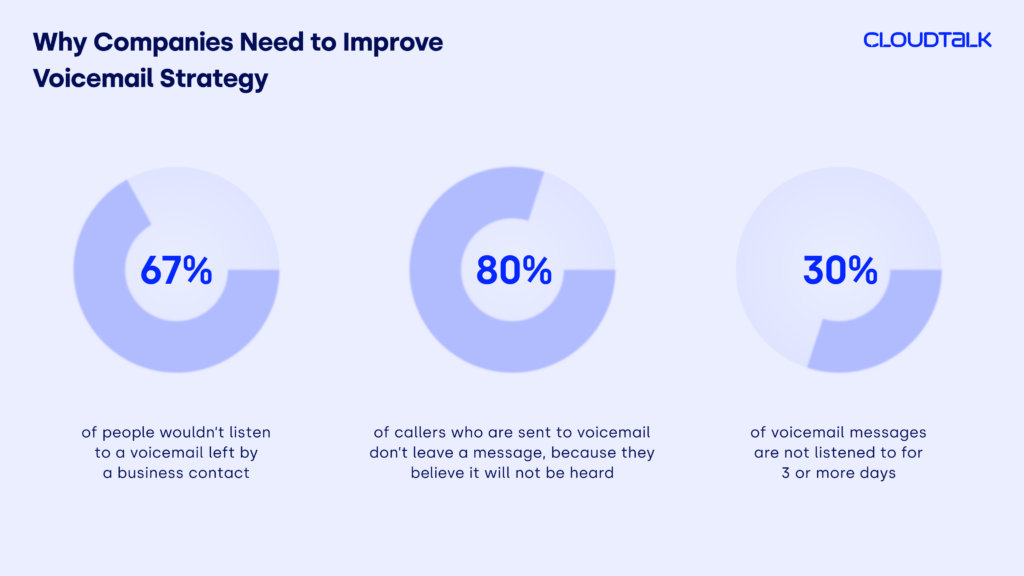5 Professional Business Voicemail Greetings
Reports from the telecommunication industry show that around 60 % of phone calls end up in voicemail. According to other researchers, it may even be 75 %. Yet, voicemail is an overly underestimated feature in the business world, which radically lowers its credibility.
NewYork Times claims that 30 % of voicemail recordings are being heard just after 3 days or later. That can be a reason why as much as 80 % of callers don’t believe their messages are noted.
You may want to reconsider this approach. Voicemail is a handy tool that allows customers to interact with you, even though they cannot reach you at the given time. Though, to encourage customers to leave you a message, you should first gain their attention by crafting impressive professional phone greetings that no one will abandon.
Start calling with a complimentary virtual phone number for 14 days free!
Why are voicemail greetings important for business?
According to Nectafy, 88% of people who are searching for a given local business will either call or visit the office in 24 hours. But if your company doesn’t have much else to offer besides a busy signal, there’s a good chance that the caller will hang up and look for another company. One that gives a chance to express his/her needs. You just lost a potential customer.
Obviously, you cannot answer all of your calls immediately. For this reason, you need to have professional business phone greetings prepared.

4 key ways how a quality voicemail greeting helps your brand
#1 It shows that you care: An engaging voicemail greeting presents that your callers’ inquiry matters to you. You are just currently busy handling another call. An assurance that customers will hear from you as soon as possible gives them a motivation to stick with your business.
#2 It saves customers’ time: In a digital age, people consider communicating through messages more suitable, since they need to do it fast. Through a tailored voicemail greeting, you let them know they have an opportunity to inform you about their inquiry without waiting in line or calling multiple times.
#3 It assures accuracy: Voicemail guarantees that every case will be handled by a competent person, without a need to repeat the same issue multiple times. Voicemail messages also lower the chances of misunderstandings and prepare agents for a follow-up. A proper but prompt callback makes wonders in strengthening business relationships.
You may consider features like our automatic callback that significantly reduces call abandonment rate.
#4 It assists with missed calls management: Voicemail messages let you know which cases are truly urgent and need immediate attention and which can wait a bit. Take into consideration that a customer or lead who left a voicemail message already showed a deeper interest in your services. It may be more profitable for you to focus on them first.
What to include in professional phone greeting
Voicemail greetings have a basic structure of what they should contain. Following it may be your base for tailoring a perfect message:
- An initial greeting
- Your name and the name of your business
- An apology for your unavailability and a brief explanation
- An estimated time when you may get back to the caller
- A request for caller’s identity and a his/her reason for contacting you
- An alternative contact method in case the matter is extremely urgent, f.e. email
- Call to action, such as “Leave a message after signal”
- Thank the caller for taking a time to leave the message
PRO TIP: If you have callers in different time zones, be sure to include your business hours and your time zone, so you communicate precisely and set expectations clearly.
Phone greetings best practices
There are several attributes of a high quality business phone greetings you need to keep in mind.
- Be original: Some phrases such as “Your call is important to us” have been used so many times that they no longer make a good impression on callers. Keep the greeting original. You may even go bold and use humor. Below, we are showcasing specific examples of this approach.
- Make it easy to the ear: Make sure there is no background noise during recording. That can make the voicemail greeting difficult to understand. Also, keep your greetings easy to listen to and personal. Speak clearly and slowly. Don’t be too robotic.
- Stay brief and efficient: Don’t forget that one purpose of voicemail is also to save customers’ time. Avoid recording 2 minutes long greetings with all the fluff that is not relevant. Keep it short and to the point. The recommended length is between 24 to 30 seconds maximum, otherwise a caller may hang up in the middle of your message.
- Be cheerful: Smile while recording your phone greeting. This might sound silly, but when you are smiling, listeners can hear you as upbeat, open and friendly.
PRO TIP: If needed, you can assure a quality of your greetings by using professional voice actors.
Discover the Future of Conversations
5 examples of typical business phone greetings
Nowadays, one generic voicemail greeting for all situations often doesn’t cut it. If you want your company to be seen as trustworthy, you have to prepare personalized greetings that suit your business and current situation.
Preparing several specific greetings may sound time-consuming, but it pays off in the end. It not only boosts your customer satisfaction rate, but also your profit.
Below, you can find examples of voicemail greetings for most common situations.
PRO TIP: Keep in mind that default scripts are here to give you an overall understanding of the issue. Using one of those as your company’s official greeting is not recommended, since they don’t correspond with your brand voice.
#1 Standard business voicemail message
This is a greeting that plays when you are at work, but currently unavailable for whatever reason. For example, you are attending a meeting. You can keep it longer, yet still at the recommended rate of maximum 30 seconds.
- EXAMPLE: “Hello, you’ve reached Customer Support at <company name>. We can’t take your call right now. Please leave your name, contact information, and the reason for reaching out. One of our team members will be in touch with you as soon as possible. You may also visit our website [company website URL] for more options. Thank you for contacting us.”
#2 On-hold personalized voicemail message
This is what the customer hears when queuing, since all of your agents are currently handling another case. Customers may wait in the queue or leave a voicemail right away.
- EXAMPLE: “Dear caller, all of our agents are currently busy. Please stay on the line, and an agent will answer your call as soon as possible. You can also choose an option to leave a message. Thank you for your patience.”
#3 Out of office voicemail message
If your team is away, we recommend tailoring specific messages for these purposes. It is especially useful if you wish to let customers know that your office is available in specific business hours. This way, you set an expectation of when customers can reach you or when they may reach you.
- EXAMPLE: “Hi, you’ve reached <company name>. We are currently unavailable. Our standard opening hours are from 9 am to 5 pm, from Monday until Friday. You can visit our website for related information. If you’d like to leave us a message, provide your name, number, and reason for your call after the beep. Thank you.”
#4 Holiday voicemail message
Companies are usually not working during holidays, such as Christmas. You need to inform a customer when you will be back. This greeting can also be a bit more informal, since holidays are cheerful times of the year.
- EXAMPLE: “Hello, <company name/team’s name> is out until [date]. We’ll make sure to call you back straight away when we return. If your request is urgent, leave us an email at [company email address]. Thank you. Have a lovely holiday.”
#5 Funny voicemail message
When we talk informal, you can try to use humor in your message. This approach is really effective in keeping customers’ attention, since they are usually amused and want to hear where you are aiming.
Yet, evaluate whether this type of phone greeting is appropriate for your brand image. It may work with creative industries but may not work with strictly professional ones, such as finance.
- EXAMPLES: “Hi, you’ve reached <your name> at <company name>. We are busy saving the world by <add what your company does best>. If you want to learn more about how we do it, please leave us your name and phone number, and we will get back to you as soon as our mission is complete. Which should be fairly soon. Thank you!”
- “Hello! You’ve gotten the voicemail of <your name> at <your company name>. Leave your name, contact information, and the answer to the eternal question ‘Which came first, the chicken or the egg?’ Anyone who gets it right will receive a call back. Thank you.”
Phone greetings no-go examples
Now, when you are inspired by some well-constructed message greetings, let’s take a look at a few no-goes and brainstorm at what can be improved.
Example 1
“Hello, this is <your name>. Leave me a message.”
Why is it wrong?
This message provides no relevant information, besides your name. Customers have no idea what you need from them to follow up, and when or if you can possibly get back to them.
It may also sound pretty rude. This way, clients think you don’t care enough to provide more details.
Example 2
“Hi, you’ve reached the desk of <your name>. I am out of the office right now with <personal reason> and won’t be available for at least a week. You can reach me at <home or personal cell phone address> in the event of an emergency, or call my assistant, <name>, at <number>. Again, I’m very sorry I missed your call. Leave a message after the tone and I’ll get back to you as soon as I can or after I return from <personal reason>.”
Why is it wrong?
In contrast to the previous one, this message contains too much information. As much as you may want to share it, the customer doesn’t necessarily need to know the exact reason for your absence if it’s personal. Also, try to construct shorter, more coherent sentences and don’t repeat yourself. Although it is important to apologize, there’s no need to do it twice.
Another problem with this message is that though it contains a lot of information, it doesn’t say too much. Phrases like “at least a week” have no value. Share a precise date or if you are not sure, rather don’t share it at all. It is enough to mention you’ll call back ASAP and provide contact in case of high urgency.
Test your voicemail greetings
You can feel confident that you just crafted the best voice greeting that is ready to blow your customers’ minds. Yet often, authors incline to miss their own mistakes. It’s a good idea to first rehearse the recording a couple of times or ask your coworker to give you “second eyes”.
Then, once recorded, listen to the greeting yourself before you’ll let customers hear it. Dial the number from a personal phone and wait until you’ll be redirected to a voicemail or choose to leave a message. Then, in your work calling system, double-check if everything works as it should. Is the message available?
As the following step, go through your call statistics. There, you may see how customers interact with your calls. For example, how many users hear your voicemails and how they respond. Do they hang up frequently? If so, you need to brainstorm what can be the reason. You can also A/B test your greetings to find out which work and which don’t.

One of the reasons customers don’t interact with your voicemail can also be background noise or low sound quality. It is necessary to test whether on-hold music plays correctly. If the background track is of bad quality, callers are much more likely to abandon the call.
Besides audio, test how the content works for your customers. If they often don’t leave all the information you need, there’s probably something missing in your message. Think about how you can make it more efficient.
There is also a possibility that your business phone greeting is outdated. Make sure it reflects your current situation. For example, if your message says your team is on holiday while it’s a month after Christmas, customers may consider you unprofessional and careless. Or, maybe your working hours changed and although your voicemail greeting says you are available at a given time, you are actually long gone.
Be sure you refresh your content periodically.
Set business phone greetings with a virtual phone system
If you’re struggling with voicemail greetings, no worries. Nowadays, you can count on a virtual call center software – like CloudTalk – to lend you a hand. With several handy tools and features you cannot have while using a landline phone, it can make your and your customer support team’s job a lot easier.
With a virtual phone system, you are able to:
- Set specific groups, depending on your needs, and sort the incoming calls into groups (call redirection). The caller would therefore be redirected to the right agent for their issue.
- Set your business hours inside the app. You may also schedule that all calls and messages that are coming after business hours should be redirected to a given number.
- Record all calls so that they can be analysed later.
By using tools such as Cloudtalk, you may also set up as many customized professional business phone greetings as you wish and schedule when you want each to be played.
Apart from those mentioned above, virtual phone systems allows you to prepare various other types of messages, f.e.:
- Welcome greeting – a standard voice message greeting customers will hear when calling a call center.
- Interactive Voice Response – an easy to use menu that provides relevant information for callers or helps them with picking the right agent/department for a given issue.
Need a powerful but easy to use virtual phone system for your company?
CloudTalk is an advanced software that may take your voicemail greetings to a whole new level. Our features work seamlessly for big companies as well as for smaller, growing businesses. Check out all of the CloudTalk advanced features and try it for free!

























